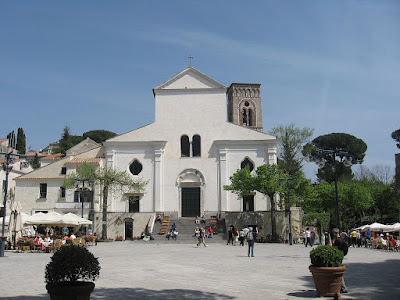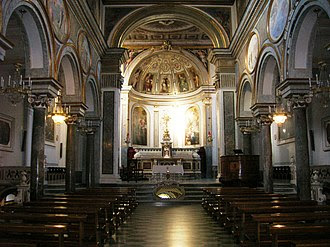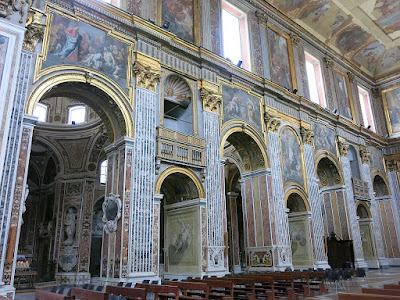Basilicas in Italy—Campania 2
I blogged about the following basilica on November 13, 2019.
- Co-Cathedral Basilica of Our Lady Queen of Peace in Campagna.
Basilica of St. Our Lady of the Assumption and St. Pantaleon, Ravello, Salerno
Declared a minor basilica by Pope Benedict XV in 1918.
The church was constructed in the 11th Century in a Romanesque style and was built as the cathedral for a diocese that is now suppressed. A major renovation was undertaken in the mid-1700s that utilized a Baroque style.
All pictures are from Wikipedia.
Basilica of St. Dominic, Naples, Naples
Declared a minor basilica by Pope Benedict XV in 1921.
The Basilica is part of a large complex of buildings constructed between 1283 and 1324 initially in a Gothic style. Later renovations added Baroque elements. The Basilica itself has 27 chapels.
It became the headquarters of the Dominican Order in Southern Italy and St. Thomas Aquinas lived and taught here in the last two years of his life. His cell has a painting of the crucifixion and Thomas often prayed in front of the painting. It is said that he conversed with Our Lord at times through the painting and was also seen to levitate in ecstasy.
All pictures are from Wikipedia.
Basilica Shrine of the Most Holy Mary, Mother of God, Nocera Superiore, Salerno
Declared a minor basilica by Pope Pius XI in 1923.
A painting of the Madonna and Child were said to be found buried near an oak tree by a peasant woman in the early 11th Century. Pilgrims came to pray to Our Lord and Our Blessed Mother and miracles were said to have occurred. The current neoclassical church was built in 1060. Various religious orders administered the church, which is now in the care of the Franciscans.
The first picture is from a local source and the others are from Wikipedia.
Basilica of St. Anthony the Abbot, Sorrento, Naples
Declared a minor basilica by Pope Pius XI in 1924.
The church was built in the 11th Century and contains the mortal remains of St. Anthony. It was originally Romanesque but Baroque elements were later added.
The first two pictures are from Expedia and the last two are from Wikipedia.
Cathedral Basilica of Sts. Peter and Paul, Sessa Aurunca, Caserta
Declared a minor basilica by Pope Pius XI in 1929.
The church is the Cathedral for the Diocese of Sessa Aurunca. The Romanesque church was built mostly in the 12th Century. Baroque elements were later added. The granite ambo dates to the 13th Century.
All pictures are from Wikipedia.
Basilica of the Mother of God and St. Gerard Majella, Materdomina, Avellino
Declared a minor basilica by Pope Pius XI in 1930.
The church dates to at least 1200 to honor apparitions of the Virgin Mary to shepherds at a date lost to history. Pilgrims have come here for centuries and the neoclassical church has been enlarged and renovated over the years, especially after earthquakes. St. Alphonsus Liquori visited in 1748 and established a Redemptorist monastery. One of the Redemptorists, Gerard Majella died here in 1755 and has since been canonized. Pilgrims have come to see his tomb which is now located in a church next to the Basilica. This second church was built in the late 20th Century.
Both pictures are from Wikipedia.
Basilica of Our Lady of the Elm, Cava de’ Tirreni, Salerno
Declared a minor basilica by Pope Pius XI in 1931.
It is believed that shepherds found a painting of the Virgin Mary in an elm tree in the 11th Century. A chapel was built to serve the pilgrims and the current church was built in the late 15th Century.
The first picture is from the basilica website and the other two are from local sources.
Basilica of St. Mary Major, Piedimonte Matese, Caserta
Declared a minor basilica by Pope Pius XII in 1945.
The church was built in the 18th Century and has works of art from previous centuries.
The first picture is from Flickr and the second is from a local source.
Cathedral Basilica of St. Proculus, Pozzuoli, Naples
Declared a minor basilica by Pope Pius XII in 1949.
The church is the Cathedral for the Diocese of Pozzuoli. Around 500 A.D., a Roman temple was converted to a Christian church. It was replaced between 1636 and 1637 by a neoclassical and Baroque building. It closed in 1964 after a serious fire and reopened in 2014. The Basilica has many paintings.
All pictures are from local sources except the last which is from Wikipedia.
Basilica of St. Paul Major, Naples, Naples
Declared a minor basilica by Pope Pius XII in 1951.
The Baroque church was completed in 1630 and is built on the site of a Roman temple. The church was embellished in later centuries. It was severely damaged in the Second World War but has been restored.
All pictures are from Wikipedia.
Cathedral Basilica of the Assumption of Mary, Nola, Naples
Declared a minor basilica by Pope Pius XII in 1954.
The basilica is the cathedral for the Diocese of Nola. There has likely been a church on this site for centuries—the Diocese was established in the 2nd Century. The current church was built in a Gothic style in the 14th Century and contains the tomb of St. Felix, an early martyred bishop. The church was rebuilt in 1583 and more recently in the late 1800s. The most recent renovation used the neoclassical style.
Both pictures are from Wikipedia.
Basilica of the Holy Cross, Torre del Greco, Naples
Declared a minor basilica by Pope Pius XII in 1957.
The church was originally built in the 16th Century and apparently was very lovely. Unfortunately, it did not survive the 1794 eruption of Mount Vesuvius. Reconstruction took place between 1795 and 1827 and resulted in a Baroque and Neoclassical building. It has a chapel with a relic of the True Cross obtained after a similar relic was lost to the volcano. The Basilica has numerous works of art.
All pictures are from Wikipedia.













































No comments:
Post a Comment